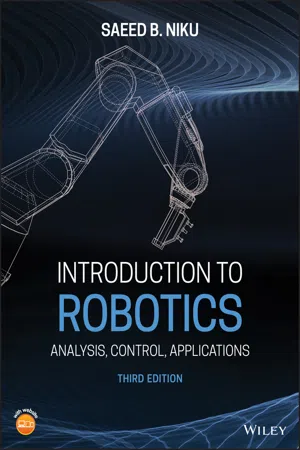
- English
- ePUB (mobile friendly)
- Available on iOS & Android
About this book
Introduction to Robotics: Analysis, Control, Applications, 3rd Edition
The revised text to the analysis, control, and applications of robotics
The revised and updated third edition of Introduction to Robotics: Analysis, Control, Applications, offers a guide to the fundamentals of robotics, robot components and subsystems and applications. The author—a noted expert on the topic—covers the mechanics and kinematics of serial and parallel robots, both with the Denavit-Hartenberg approach as well as screw-based mechanics. In addition, the text contains information on microprocessor applications, control systems, vision systems, sensors, and actuators.
Introduction to Robotics gives engineering students and practicing engineers the information needed to design a robot, to integrate a robot in appropriate applications, or to analyze a robot. The updated third edition contains many new subjects and the content has been streamlined throughout the text. The new edition includes two completely new chapters on screw-based mechanics and parallel robots. The book is filled with many new illustrative examples and includes homework problems designed to enhance learning. This important text:
- Offers a revised and updated guide to the fundamental of robotics
- Contains information on robot components, robot characteristics, robot languages, and robotic applications
- Covers the kinematics of serial robots with Denavit-Hartenberg methodology and screw-based mechanics
- Includes the fundamentals of control engineering, including analysis and design tools
- Discusses kinematics of parallel robots
Written for students of engineering as well as practicing engineers, Introduction to Robotics, Third Edition reviews the basics of robotics, robot components and subsystems, applications, and has been revised to include the most recent developments in the field.
Frequently asked questions
- Essential is ideal for learners and professionals who enjoy exploring a wide range of subjects. Access the Essential Library with 800,000+ trusted titles and best-sellers across business, personal growth, and the humanities. Includes unlimited reading time and Standard Read Aloud voice.
- Complete: Perfect for advanced learners and researchers needing full, unrestricted access. Unlock 1.4M+ books across hundreds of subjects, including academic and specialized titles. The Complete Plan also includes advanced features like Premium Read Aloud and Research Assistant.
Please note we cannot support devices running on iOS 13 and Android 7 or earlier. Learn more about using the app.
Information
1
Fundamentals
1.1 Introduction
1.2 What Is a Robot?
Table of contents
- Cover
- Table of Contents
- Preface
- About the Companion Website
- 1 Fundamentals
- 2 Kinematics of Serial Robots: Position Analysis
- 3 Robot Kinematics with Screw‐Based Mechanics
- 4 Kinematics Analysis of Parallel Robots
- 5 Differential Motions and Velocities
- 6 Dynamic and Force Analysis
- 7 Trajectory Planning
- 8 Motion Control Systems
- 9 Actuators and Drive Systems
- 10 Sensors
- 11 Image Processing and Analysis with Vision Systems
- 12 Fuzzy Logic Control
- Appendix A: Appendix A
- Appendix B: Appendix B
- Index
- End User License Agreement